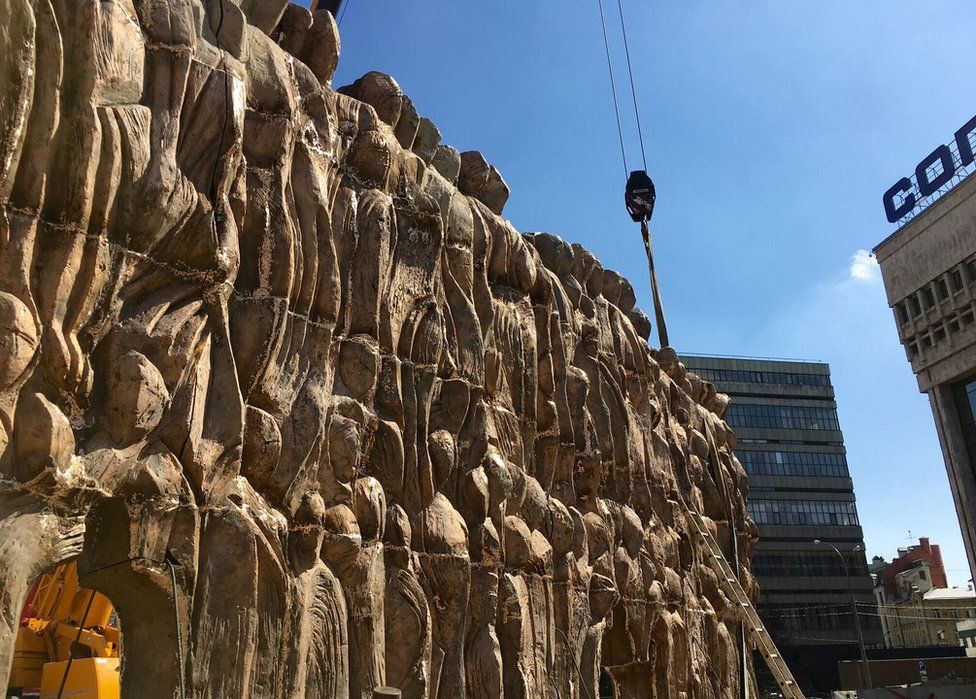Wall of Grief: Russia remembers victims of Soviet repression
- Published

Vera Golubeva spent six years in a Stalinist labour camp for telling a joke. In 1951 she was labelled an enemy of the people and sent to Siberia.
"It sounds ridiculous," the former history teacher smiles. "But that's the only 'evidence' they had on me."
Now almost 98, Vera walks slowly, leaning on a stick. But this woman was once forced to lay railway sleepers made of cement in temperatures that plunged to minus 56 degrees Celsius.
Vera Golubeva was a teacher when she was put in prison for telling a joke
"Everyone was exhausted and got sick," she recalls, as we talk on a bench in the yard of her Moscow apartment block. "The hardest part for me was chopping wood. I was a city girl and not very good at it. So my food ration was cut to 300 grams. That's nothing!" she says.
"It was psychologically tough, too. Many people went out of their minds. They couldn't cope," she says.
Now Russia is preparing to pay its respects to millions of people like Vera.
Just alongside Moscow's central ring road, the pieces of a vast bronze sculpture are being slotted into place. It is Russia's first ever national memorial to the millions deported, imprisoned and executed in Soviet times.
Most were victims of Joseph Stalin's brutal, paranoid rule.
Stalin's victims
- Tens of millions died under Joseph Stalin, who ruled the Soviet Union between 1929-53
- Victims lost lives in deportations, famine, forced collectivisation, executions and in prison camps
- Estimated 750,000 people summarily killed during Great Terror of 1937-38
- Millions were sent to Gulag labour camps
"It was a catastrophe on a universal scale, one of the greatest human atrocities. It was impossible for me not to be affected by that," explains artist Georgy Frangulyan, as he watches his sculpture take shape by the side of a busy road.
Made up of jagged human forms with no faces, the monument will curve like a giant scythe. The artist says that is meant as a physical reminder of a repressive machine that mowed down innocent victims.
There are gaps in the wall which he wants people to step inside, and feel the weight of that history on their shoulders.
"It's not normal, representative art. It's an expression of feelings, of fear and alarm," Mr Frangulyan says. "It depicts all the lives that were scratched out ruthlessly."
The Wall of Grief is part-funded by the Moscow city government and partly by donations, though the artist says there is still a significant shortfall.
It is part of a broader government programme signed by the prime minister two years ago which states that Russia cannot adopt a leading role in the international community without "immortalising the memory of the many millions of its citizens who were victims of political repression".
And yet there are very mixed messages from the top.
In June, President Vladimir Putin himself warned that Russia's enemies were "demonising" Stalin excessively as a form of attack.
Under his rule, the Soviet victory over the Nazis has become central to a new ideology of Russian greatness.
In that context, Stalin is increasingly seen as a war hero. He regularly tops opinion polls here as an outstanding, historical figure.
'Gulag is being ignored'
But there is no need to go to Siberia to see the suffering he caused.
The Moscow canal runs for over 120km (75 miles) around the city, incorporating locks and reservoirs. Designed to allow the Volga river to flow into Russia's capital, the giant project was built with forced labour at the height of Stalin's rule. That included political prisoners.
"Most people know nothing about the canal," says researcher Dmitry Kotilevich. "They know even less about the Dmitrovsky labour camp."
At the grand opening ceremony in 1937 dozens of officials who had overseen construction on the canal were arrested and later shot, he says.
"It's very hard for many people to think about winning the war and about the Gulag at the same time," the young historian explains. "I often hear that you somehow violate the memory of [Soviet] victory by noticing what Stalin did before that. So the Gulag is being ignored."
Soon that will be harder to do.
The Wall of Grief is 30m (100ft) long and its creator believes those who pass by, including children, will be curious and ask questions.
"There will always be some who don't want to admit what happened. But I hope they will be fewer, thanks to this memorial. Brutality, the annihilation of innocent people, can never be justified," says Georgy Frangulyan.
'What happened needs to be exposed'
Vera Golubeva survived that brutality, but at huge cost.
She says her youth was stolen in the Gulag. Her husband was sent to the camps too, and her parents. Vera herself was eight months pregnant when she was taken. She lost her baby and says after that, life became pointless.
So for her the new memorial is long overdue recognition of the horror.
"What happened needs to be exposed, so it's never repeated," Vera says, her voice strong and firm despite her age.
"We say here that things go in spirals. But that was a black spiral. It was a frightening time," she adds. "Unfortunately, there are still supporters of that system."
They are not hard to find. As I leave Vera on her bench in the sunshine, another woman sitting nearby calls out.
She knew I was a foreigner, and had been watching as we talked.
"Was she criticising Russia?" the woman demands to know, pointing to Vera. "Was she saying bad things?"
"She'd better not have been. Or we'll give her what for."
- Published22 February 2016
- Published30 October 2015
- Published23 November 2013